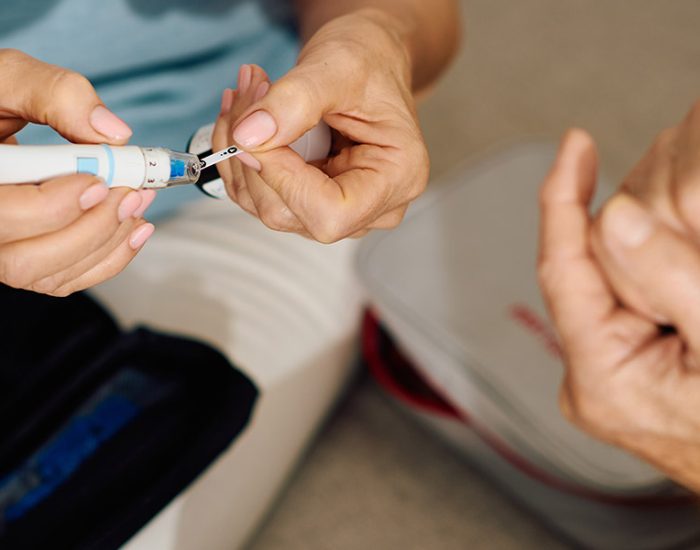Symptoms And Causes Of Bladder Leakage Among Older Women
Urinary incontinence or loss of bladder control can cause an adult to leak urine by accident. It is quite common among older adults, especially women. It can lead to a fall in self-esteem and it can cause awkward situations in public. Incontinence can be controlled and managed with proper treatment. If the problem goes beyond control, you should consult a proper doctor.
What causes urinary incontinence?
The bladder stores urine in the body. When the muscles around the bladder weaken and don’t work normally, urine can leak without warning. Incontinence can be caused due to various reasons like urinary tract infections, vaginal infection, constipation etc. Even the consumption of medicines can cause temporary loss of bladder control.
If incontinence persists for a long time in older women, it could be due to various reasons like weak and overactive bladder muscles, weak pelvic floor muscles, menopause, damage to bladder controlling nerves due to neurological problems, diabetes, etc. It could be due to arthritis where you may suffer leaks because you are unable to reach the washroom on time. Another reason could be due to pelvic organ prolapse which could cause the bladder, rectum or uterus to shift out of their normal position and cause urine to leak.
There are various types of incontinence depending on the symptoms.
Stress incontinence – This occurs when the leakage is caused by excess pressure on the bladder. Common reasons for this could be while coughing or sneezing, lifting weights or doing exercise. This can begin in women around the time of menopause.
Urge incontinence – This occurs when women feel a sudden rush to urinate but cannot hold it in till they get to a toilet. This could be caused by an underlying diabetes condition. It could also be common in those suffering from Parkinson’s or Alzheimer’s disease, stroke, multiple sclerosis etc.
Overflow incontinence – This happens when the bladder is always full and small amounts of urine leak. Diabetes and spinal cord injuries can cause this problem in older women.
Functional incontinence- This is quite common in older women even when they have normal bladder function. They may find it difficult to reach the toilet on time because of arthritis or any other condition that slows down movement.
Mixed incontinence – This occurs when you have a combination of factors. Usually, it would be a combination of stress incontinence and a hyperactive bladder which could cause leakage accidents. It is best to identify what triggers the leak to be able to manage it.
Long term urinary incontinence in women could be because of –
- Weak pelvic floor muscles can affect bladder functioning.
- A stroke can impact muscle control including the ones that control the bladder.
- Diabetes leads to excess production of urine leading to leakage problems.
- Menopause changes the hormone levels in a woman’s body causing the pelvic floor muscles to weaken and affect bladder control.
- Multiple sclerosis can cause loss of bladder control and incontinence.
It is always advisable to identify the underlying cause that is leading to urinary incontinence so that it can be treated correctly. Some of these are temporary while others may require medical treatment. While you consult a doctor, you can use Lifree adult diapers to keep you dry and comfortable. It will help you lead a normal life without any embarrassment.
FAQ’s
2. What causes bladder leakage in older women?
Bladder leakage in older women can have several causes. Aging naturally weakens the pelvic floor muscles that support the bladder, making it harder to control urination. Hormonal changes, especially after menopause, may also reduce bladder control. Medical conditions like urinary tract infections, diabetes, or neurological problems can increase the risk. In some cases, surgeries in the pelvic area or childbirth from earlier years can contribute to weakened muscles and leakage. Obesity, chronic coughing, and certain medications can worsen the condition. Understanding the cause is the first step in managing bladder leakage. By consulting a healthcare provider, women can identify the exact reason behind their symptoms and explore solutions like exercises, lifestyle adjustments, or hygiene products to improve their quality of life.
3. How does aging contribute to bladder leakage?
Aging impacts bladder function in several ways. Over time, muscles in the bladder and pelvic floor lose strength and flexibility, making it harder to hold urine effectively. Hormonal changes, especially after menopause, can affect tissues that support bladder control. Older women may also experience reduced bladder capacity, meaning they need to urinate more often. Additionally, age-related health issues like arthritis or mobility problems can make it difficult to reach the bathroom in time. In some cases, medicines taken for chronic conditions may have side effects that increase leakage. While aging naturally raises the risk of incontinence, it doesn’t mean it’s untreatable. With the right exercises, healthy habits, and medical support, older women can manage bladder leakage and lead an active, confident life without major disruptions to daily routines.
4. Can previous childbirth affect bladder control in older women?
Yes, previous childbirth can impact bladder control, even years later. Vaginal deliveries, especially multiple ones, can stretch and weaken the pelvic floor muscles, which play a crucial role in supporting the bladder. This muscle weakening can lead to stress incontinence, where urine leaks during activities like laughing, coughing, or exercising. Complications during childbirth, such as prolonged labor or large babies, may further strain these muscles. Over time, as women age, these effects may become more noticeable because natural muscle strength declines. While this can feel frustrating, it’s not uncommon. Fortunately, there are ways to strengthen pelvic muscles, such as regular pelvic floor exercises, also known as Kegels. For severe cases, consulting a healthcare provider for specialized treatments or supportive products can help improve bladder control and overall confidence.
5. Are there different types of bladder leakage?
Yes, there are different types of bladder leakage, each with unique causes. Stress incontinence happens when small amounts of urine leak during physical activities like sneezing, laughing, or lifting heavy objects. Urge incontinence involves a sudden, strong need to urinate, often followed by leakage before reaching the toilet. Mixed incontinence combines symptoms of both stress and urge incontinence. Overflow incontinence occurs when the bladder doesn’t empty fully, leading to dribbling. Identifying the type of bladder leakage is crucial because treatment varies for each. For instance, stress incontinence often improves with pelvic exercises, while urge incontinence may need bladder training or lifestyle changes. A healthcare provider can help diagnose the type through simple tests and suggest the best approach to manage symptoms effectively, improving comfort and quality of life.
6. How do hormonal changes affect bladder control in older women?
Hormonal changes, especially after menopause, significantly affect bladder control in older women. When estrogen levels drop, tissues in the pelvic area, including those supporting the bladder and urethra, become thinner and less elastic. This weakening can reduce bladder control, making leaks more likely during everyday activities like laughing, sneezing, or exercising. Lower estrogen can also lead to dryness and irritation in the urinary tract, increasing the risk of infections, which can worsen incontinence. These changes are a natural part of aging but can be managed with the right care. Simple steps like staying hydrated, practicing pelvic floor exercises, and consulting a doctor about possible treatments can help. Understanding the link between hormones and bladder health empowers women to take proactive steps to maintain comfort and confidence in daily life.
7. Can lifestyle factors increase the risk of bladder leakage?
Yes, lifestyle factors can play a big role in bladder leakage. Being overweight puts extra pressure on the bladder, increasing the chances of leaks. Diet choices, like drinking too much caffeine or alcohol, can irritate the bladder and make symptoms worse. Smoking can lead to chronic coughing, which strains pelvic muscles over time. Lack of exercise can weaken pelvic support, while constipation from poor diet or low water intake can also add pressure to the bladder. Even holding urine for too long can affect bladder function over time. Making small lifestyle changes, such as maintaining a healthy weight, eating fiber-rich foods, staying active, and limiting bladder irritants, can significantly reduce leakage. These habits not only improve bladder health but also support overall well-being, making daily life easier and more comfortable
8. Is bladder leakage a permanent condition in older women?
Not always. While bladder leakage can become more common with age, it doesn’t always have to be permanent. The outcome depends on the cause. For example, leakage caused by infections or medications often improves once the underlying problem is treated. In other cases, strengthening pelvic floor muscles through exercises like Kegels can greatly reduce or even stop leakage. For women with long-term issues, using bladder training techniques or supportive hygiene products can help manage symptoms. In severe cases, medical procedures or therapies may be recommended. The key is to address the problem early and follow a personalized care plan. With proper attention and treatment, many women experience significant improvement, allowing them to stay active, confident, and in control of their daily lives without major disruptions or embarrassment.
9. When should older women seek medical help for bladder leakage?
Older women should seek medical help if bladder leakage starts affecting their daily life, sleep, or confidence. If leaks are frequent, sudden, or come with pain, burning, or blood in urine, consulting a healthcare provider is essential. Bladder leakage isn’t just a normal part of aging—it can signal other underlying issues like infections or health conditions that need attention. It’s also important to get help if lifestyle changes and basic exercises don’t improve symptoms. A doctor can perform simple tests to find the cause and suggest treatments like pelvic exercises, bladder training, medications, or other options. Early care can make managing leakage much easier. Seeking help also provides emotional relief, as knowing the cause and having a plan improves confidence and reduces the stress linked with incontinence.
10. How can older women manage bladder leakage effectively?
Managing bladder leakage effectively involves a mix of lifestyle changes, exercises, and sometimes medical support. Strengthening pelvic floor muscles through exercises like Kegels helps improve bladder control. Maintaining a healthy weight reduces pressure on the bladder, while avoiding bladder irritants like caffeine and alcohol can decrease urgency. Staying hydrated and eating a balanced diet prevents constipation, which can worsen leakage. Bladder training techniques, such as scheduled bathroom visits, help control urges. For daily comfort, using protective hygiene products like pant-style or tape-style adult diapers ensures confidence and reduces stress. If these methods don’t work, consulting a doctor for personalized treatment—like medications or therapy—is important. With consistent care and support, many women can manage bladder leakage successfully, allowing them to stay active, independent, and comfortable in their daily routines.






















